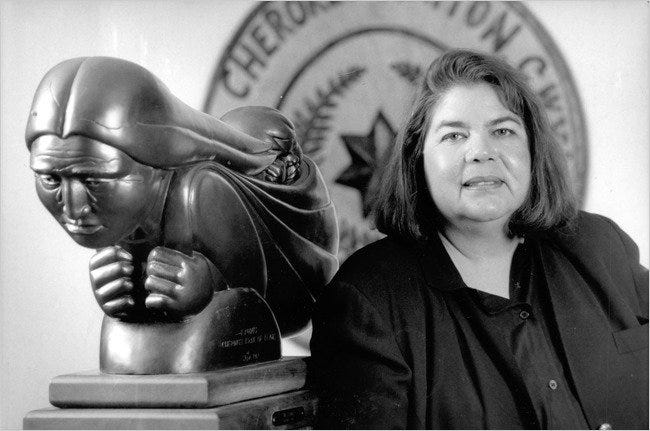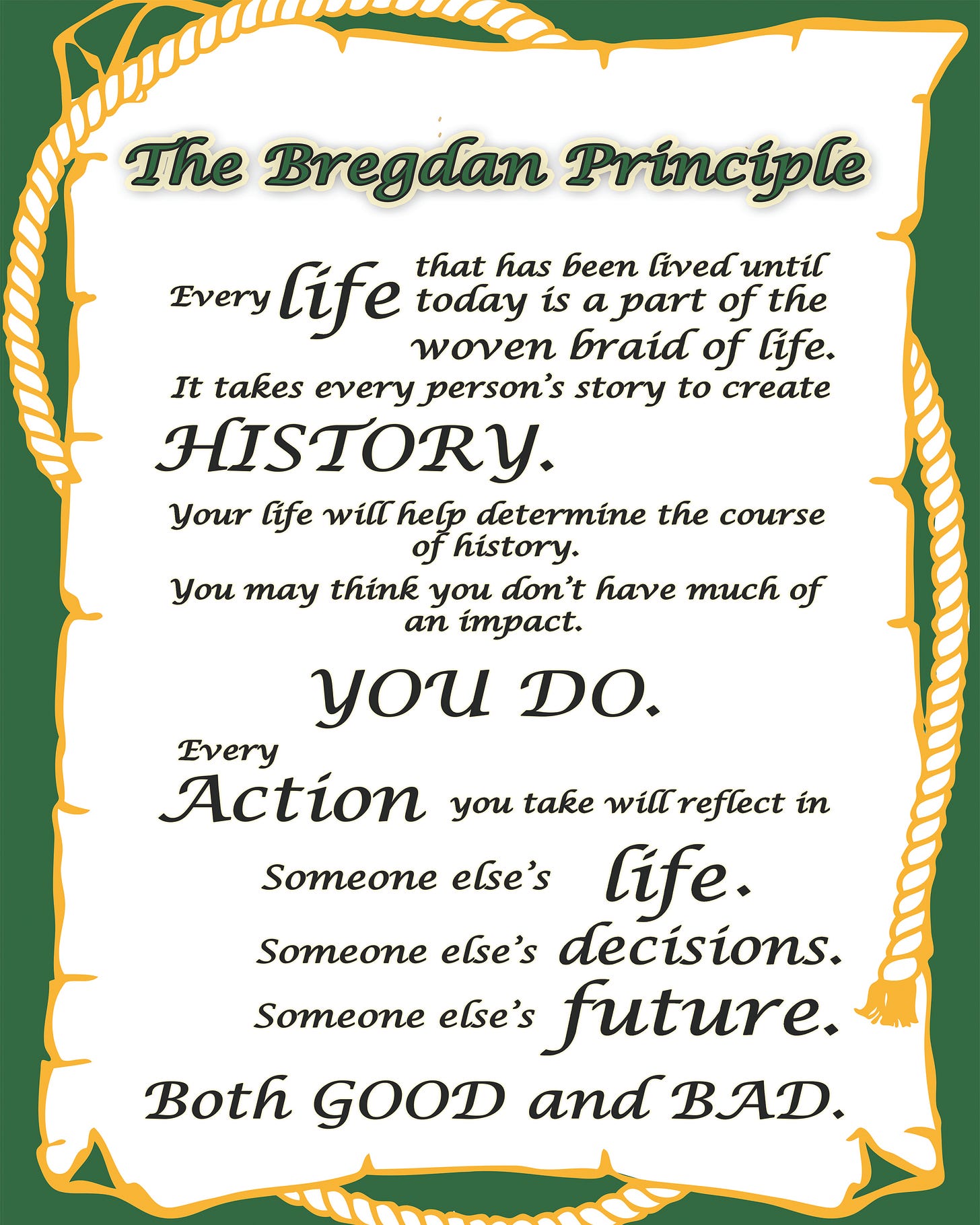Letter 60 - The First Female Chief of the Cherokee Nation!
Hello Bregdan Woman!
Ginny here…
Most of us navigate our way through the realities of life, moving our way toward an imagined goal. Life throws us curve balls. Our goals change and shift. We learn things that mandate we consider life in new ways. We follow a twisted road.
We do the best we can with the hand we are dealt.
Along the way, we impact history with every decision and choice we make. With every action we take.
Sometimes, the world learns who we are, and our names show up in history books.
That’s what happened with Wilma.
This Bregdan Woman met challenge after challenge.
To understand Wilma, you need to understand a little of her history. In the 1830’s and 1840’s, her ancestors, the Cherokee, were forced from their lands in North Carolina and Georgia by greedy white settlers who wanted their land.
Along with four other eastern tribes, approximately 100,000 people, they were herded onto the Trail of Tears. More than 15,000 died during the brutal drive to what was known as Indian Territory. Her ancestors ended up in what is now Oklahoma.
The government was confident what they called Indican Territory (now the states of Oklahoma, Kansas, Arkansas, and Iowa, was the furthest western edge of America.
They were mistaken.
As white settlers decided they wanted to expand where they lived, Indian Territory became yet another battleground. With very few rights, the Cherokee once more faced a daunting array of broken government promises.
Complete destitution was the reality of far too many Cherokee families. They tried to create a life in the midst of uncertainty and broken promises, but it was too often not possible.
Wilma was born into one of these destitute families. Her family struggled to survive.
Things got worse in 1942.
The American government, during World War II, decided her family’s land was needed for an Army base. They, along with 52 other families, were given 45 days to leave.
More broken promises!
Wilma’s family was relocated to San Francisco. They fought to start over, yet again, in a world that saw them as a problem.
Wilma was eleven.
As she grew, she became determined to create a future for herself in California, while also hanging on to her heritage. She married at 17, had 2 daughters, and then went to college. During these years, she became involved with the San Francisco Indian Center.
Wilma Mankiller developed a burning passion to help her people – the Cherokee.
Cherokee tradition honored teamwork - men and women working together, but generations of white conquest had changed all that. Deep discouragement, broken promises, and a completely male-dominated culture had replaced their historical ways.
Now the women were cast aside and forgotten. They lived hopeless and powerless. Their whole culture fought alcoholism and unemployment. An entire people were watching their old way of life die, and they felt completely helpless to change it.
Until Wilma Mankiller showed what a Bregdan Woman can do.
Wilma continued to face challenges. Her kidneys failed and death was imminent. Her brother’s gift of a kidney saved her life.
She held on to her vision to help her people.
Wilma, when she was 34, was in a head-on car collision in 1979 that killed her best friend and forced her through the agony of 17 surgeries and years of physical therapy.
She held on to her vision to help her people.
She took part in the Occupation of Alcatraz of 1969. For 19 months, she joined 89 Native American protestors from different tribes – fighting for all retired, abandoned or out-of-use-federal land to be returned to the indigenous people who once occupied it. They lived on the island together, until they were forcibly removed by the U.S. government.
The Occupation of Alcatraz is a story all to itself. (Google it!)
Wilma spent five years working as a social worker, focusing on children’s issues.
Every experience was a step toward preparing her for the future – a future she couldn’t possibly envision.
Divorce split her family.
She and her daughters returned to Oklahoma, and to the Cherokee Nation.
She held on to her vision to help her people.
She got a job with the Cherokee Nation as an economic stimulus coordinator. She continued to develop valuable management skills. She threw her full energy and effort into helping her people – gaining growing recognition as she did.
Along the way, she faced slashed tires and death threats. Though she was beloved by her people, there were many that didn’t want their male-dominated culture to change.
Sound familiar?
Nothing was going to stop this Bregdan Woman.
6 years later, in 1983, she was elected deputy chief of the Cherokee Nation. 2 years later, the Chief resigned to take a position in the federal Bureau of Indian Affairs.
She took his position and became CHIEF MANKILLER.
Just 2 years after that, she ran her own campaign and became the first elected female Chief of the Cherokee Nation.
Her true battles began after that election. She had been elected by her people, but the male-dominated Cherokee Nation leadership wasn’t going to make it easy for her.
She didn’t expect easy, but she also wasn’t going to let anyone stand in the way of her vision for her people.
The Cherokee Nation’s day had finally come again.
She was elected twice more. In the 10 years she served as Chief, the Cherokee Nation changed radically. The tribe grew from 55,000 to 196,000. Their annual budget $75 million plus, and there were more than 1200 employees.
During her administration, the Cherokee government built new health clinics, created a mobile eye-care clinic, established ambulance services, and created early education, adult education, and job training programs.
She developed revenue streams, including factories, retail stores, restaurants, and bingo operations, while establishing self-governance, allowing the tribe to manage its own finances.
It was her determination to change life for the Cherokee people that made her so beloved. She revitalized their entire economy. She revitalized their education system – giving hope to young people who had no hope before.
Equally important, she did much to restore the traditional equality between men and women.
Women now stepped forward to claim their place and power within the Cherokee Nation.
Wilma Mankiller restored faith to a desperate people.
Health issues forced her to step down in 1995. The great Cherokee Chief died in 2010, but she showed what the determination and the vision of a Bregdan Woman can do.
Wilma Mankiller didn’t take the easy way, or the quick way. She took the way that was necessary and needed.
This woman means so much to me because my great-grandmother was full-blood Cherokee. I am so proud to carry her blood. She holds a special place in my heart. Someday, I will tell her story.
I cheered when I read about what Wilma Mankiller did for her people.
You know, too many times we look for the quick way when change is needed. I prefer quick as much as anyone else (probably more), but it’s not always the best way.
Wilma is a wonderful reminder that sometimes it takes a willingness to work within the existing structure. It takes patience to wait for the opportunity that we desire to present itself.
By patiently working within her Nation, Wilma created an environment where her people have hope. Present day young Cherokee girls dream of becoming chief. Before her election, girls would never have believed it was possible.
I can’t know what kind of road you need to take to create the changes you want to make, but I can encourage you to take the actions you need to take to become a Bregdan Woman yourself!
*********************************
What will you do to be a Bregdan Woman?
What will you do today to impact history??
We’re on this journey with you… (and have 2 FREE Gifts for you below…)
Ginny & Suess






I had an uncle on my father's side who was always adament that we had Native American ancestors. I've been trying to dig into our ancestry a bit to find out if that's true or not. Regardless, I enjoy learning the history. To become chief after all the hardships she endured is a testament to how brave, strong and resillant Wilma Mankiller was. Thank you for sharing her story!
What a story! A real hero. I was so glad you had her picture. As always thank you for sharing.
BetteM